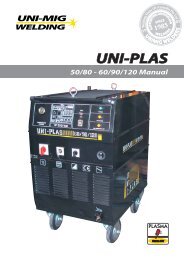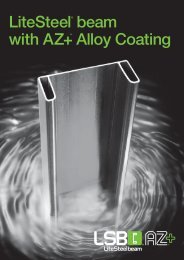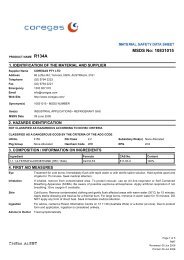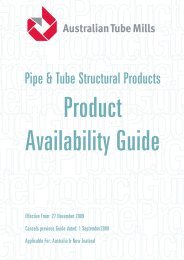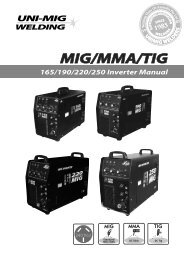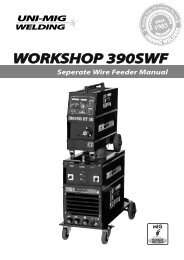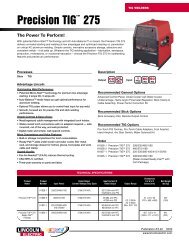Weldmatic 175 [internal wirefeeder] - BJH
Weldmatic 175 [internal wirefeeder] - BJH
Weldmatic 175 [internal wirefeeder] - BJH
Create successful ePaper yourself
Turn your PDF publications into a flip-book with our unique Google optimized e-Paper software.
<strong>Weldmatic</strong> <strong>175</strong>Burn protectionThe welding arc is intense and visibly bright.Its radiation can damage eyes, penetratelight-weight clothing, reflect from lightcolouredsurfaces, and burn the skin andeyes. Burns resulting from gas-shielded arcsresemble acute sunburn, but can be moresevere and painful.Wear protective clothing - leather or heatresistant gloves, hat, and safety-toe boots.Button shirt collar and pocket flaps, andwear cuffless trousers to avoid entry ofsparks and slag.Avoid oily or greasy clothing. A spark mayignite them. Hot metal such as electrodestubs and work pieces should never behandled without gloves.Ear plugs should be worn when welding inoverhead positions or in a confined space.A hard hat should be worn when others areworking overhead.Flammable hair preparations should not beused by persons intending to weld or cut.Toxic fumesAdequate ventilation with air is essential.Severe discomfort, illness or death canresult from fumes, vapours, heat, or oxygendepletion that welding or cutting mayproduce. NEVER ventilate with oxygen.Lead, cadmium, zinc, mercury, and berylliumbearing and similar materials when weldedor cut may produce harmful concentrationsof toxic fumes. Adequate local exhaustventilation must be used, or each person inthe area as well as the operator must wearan air-supplied respirator. For beryllium, bothmust be used.Metals coated with or containing materialsthat emit fumes should not be heated unlesscoating is removed from the work surface,the area is well ventilated, or the operatorwears an air-supplied respirator.Work in a confined space only while it isbeing ventilated and, if necessary, whilewearing air-supplied respirator.Vapours from chlorinated solvents can bedecomposed by the heat of the arc (orflame) to form phosgene, a highly toxicgas, and lung and eye irritating products.The ultra-violet (radiant) energy of the arccan also decompose trichlorethylene andperchlorethylene vapours to form phosgene.Do not weld or cut where solvent vapourscan be drawn into the welding or cuttingatmosphere or where the radiant energycan penetrate to atmospheres containingeven minute amounts of trichlorethylene orpercholorethylene.Fire and explosion preventionBe aware that flying sparks or falling slag canpass through cracks, along pipes, throughwindows or doors, and through wall or flooropenings, out of sight of the operator. Sparksand slag can travel up to 10 metres from the arc.Keep equipment clean and operable, free ofoil, grease, and (in electrical parts) of metallicparticles that can cause short circuits.If combustibles are present in the workarea, do NOT weld or cut. Move the work ifpracticable, to an area free of combustibles.Avoid paint spray rooms, dip tanks, storageareas, ventilators. If the work can not bemoved, move combustibles at least 10metres away out of reach of sparks and heat;or protect against ignition with suitable andsnug-fitting fire-resistant covers or shields.Walls touching combustibles on oppositesides should not be welded on or cut. Walls,ceilings, and floor near work should beprotected by heat-resistant covers or shields.Model No CP122, Iss A 07/07


![Weldmatic 175 [internal wirefeeder] - BJH](https://img.yumpu.com/48683580/5/500x640/weldmatic-175-internal-wirefeeder-bjh.jpg)


